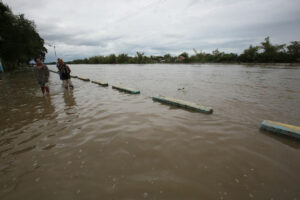THE GOVERNMENT will implement an integrated water management program that will link the flood control system to serve the needs of irrigation, water supply, and power, officials said on Tuesday.
They added that remote island communities will get desalination plants to simplify the logistics of water provision.
The water management program hopes to leverage funding sources like the flood control budget of about P300 billion in 2024, Public Works Secretary Manuel M. Bonoan said at a Palace briefing following a meeting with President Ferdinand R. Marcos, Jr.
“We have to integrate our flood control management programs with the other sectors so that the water that we manage in the flood control system does not go to the sea directly,” he said.
“We have to conserve and utilize it for other purposes like for irrigation, water supply and power if necessary.”
In meetings at the Palace earlier in the day, Mr. Marcos cited the need to come up with a water resource masterplan amid pressures from El Niño as well as the anticipated shift to La Niña, which produces above-normal rainfall.
The President said the Public Works and Environment departments should explore foreign funding for water resource management programs.
At the same Palace briefing, Environment Undersecretary Primo David said the government will deploy modular desalination systems — each costing between P5 million and P8 million — to give small island communities access to clean water.
He said the government could finance this program through loans or a bond issue. An estimated 40 million Filipinos have no formal access to water.
The government is also considering foreign partnerships to execute the desalination plan, he added.
“We were looking for suppliers from Israel, the Netherlands, and Singapore,” he said. “I was pleasantly surprised that we have four companies that have the technical capability to implement these kinds of project.”
The Philippines still falls short of the targeted annual investment of P119 billion to achieve universal access to safe water and sanitation services by 2030, hitting only an average of P6 billion in investment annually in water infrastructure over the last five years, according to the Palace. — Kyle Aristophere T. Atienza
